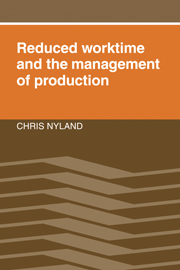2 - Empirical evidence and worktime theory
Published online by Cambridge University Press: 25 March 2010
Summary
The review of the literature presented in Chapter 1 has shown that there currently exist two major theories that purport to explain the changing nature of worktime in industrialised capitalist societies. Marginalism argues that the downward drift in standard times has occurred because the living standards of the workers and the pattern of their preferences for income and leisure have changed. Marxism, on the other hand, argues that while individual workers' desires are not necessarily irrelevant in bringing about such change, it is within the production process rather than within the consciousness of individuals that one should seek the answer to why standard times have tended to fall. In this chapter the empirical evidence underpinning both modern marginalism and Marx's argument, and hence the arguments of those radicals who limit their analysis to the political realm, will be looked at in order to determine the validity and contemporary relevance of each.
Marginalism
For modern marginalists the primary prop upon which their theory of worktime stands is the claimed existence of a negative slope in the relevant portion of the labour-supply curve. To be able to prove empirically that the majority of workers choose to reduce their worktime as their incomes rise is crucial to the theory, because even within its own parameters there is no logical reason to assume that this should be the case.
In 1930 Robbins published his classic paper “On the Elasticity of Demand for Income in Terms of Effort.” In this work Robbins criticised those economists who claimed that it was possible, by a priori reasoning, to determine how a change in income will influence the labour supply of the individual.
- Type
- Chapter
- Information
- Reduced Worktime and the Management of Production , pp. 37 - 66Publisher: Cambridge University PressPrint publication year: 1989



